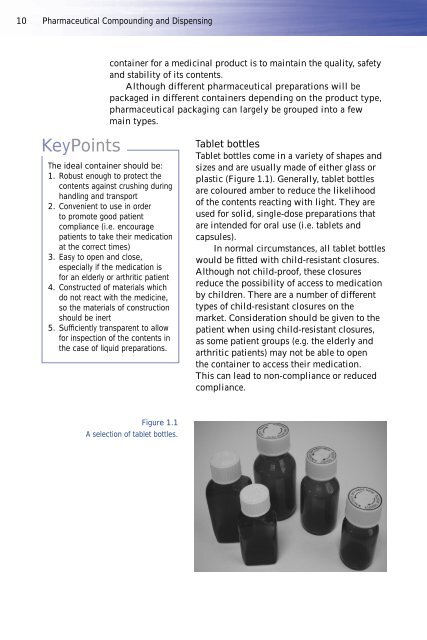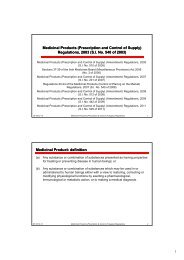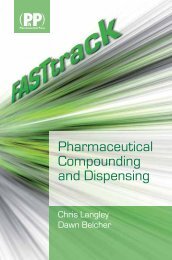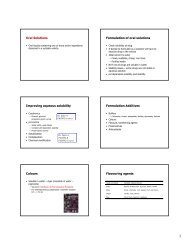Pharmaceutical Compounding and Dispensing - Pharmaceutics
Pharmaceutical Compounding and Dispensing - Pharmaceutics
Pharmaceutical Compounding and Dispensing - Pharmaceutics
You also want an ePaper? Increase the reach of your titles
YUMPU automatically turns print PDFs into web optimized ePapers that Google loves.
10<br />
<strong>Pharmaceutical</strong> <strong>Compounding</strong> <strong>and</strong> <strong>Dispensing</strong><br />
KeyPoints<br />
container for a medicinal product is to maintain the quality, safety<br />
<strong>and</strong> stability of its contents.<br />
Although different pharmaceutical preparations will be<br />
packaged in different containers depending on the product type,<br />
pharmaceutical packaging can largely be grouped into a few<br />
main types.<br />
The ideal container should be:<br />
1. Robust enough to protect the<br />
contents against crushing during<br />
h<strong>and</strong>ling <strong>and</strong> transport<br />
2. Convenient to use in order<br />
to promote good patient<br />
compliance (i.e. encourage<br />
patients to take their medication<br />
at the correct times)<br />
3. Easy to open <strong>and</strong> close,<br />
especially if the medication is<br />
for an elderly or arthritic patient<br />
4. Constructed of materials which<br />
do not react with the medicine,<br />
so the materials of construction<br />
should be inert<br />
5. Suffi ciently transparent to allow<br />
for inspection of the contents in<br />
the case of liquid preparations.<br />
Figure 1.1<br />
A selection of tablet bottles.<br />
Tablet bottles<br />
Tablet bottles come in a variety of shapes <strong>and</strong><br />
sizes <strong>and</strong> are usually made of either glass or<br />
plastic (Figure 1.1). Generally, tablet bottles<br />
are coloured amber to reduce the likelihood<br />
of the contents reacting with light. They are<br />
used for solid, single-dose preparations that<br />
are intended for oral use (i.e. tablets <strong>and</strong><br />
capsules).<br />
In normal circumstances, all tablet bottles<br />
would be fi tted with child-resistant closures.<br />
Although not child-proof, these closures<br />
reduce the possibility of access to medication<br />
by children. There are a number of different<br />
types of child-resistant closures on the<br />
market. Consideration should be given to the<br />
patient when using child-resistant closures,<br />
as some patient groups (e.g. the elderly <strong>and</strong><br />
arthritic patients) may not be able to open<br />
the container to access their medication.<br />
This can lead to non-compliance or reduced<br />
compliance.<br />
w





